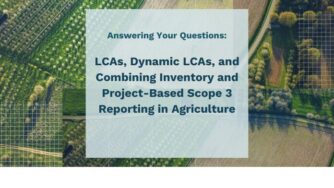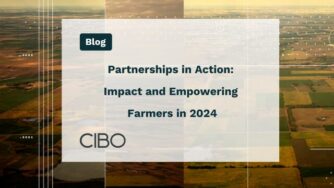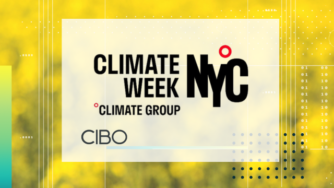CIBO hosted a webinar featuring our data science team to discuss why data scientists should be paying attention to agriculture. The topics included computer vision and simulation at CIBO, the process of data science, the SALUS model, satellite and other technologies, accuracy of the technology, and the outcome to scaling regenerative agriculture. The key takeaway was that data science helps CIBO scale regenerative agriculture and is a crucial part of the climate solution. Here’s a summary of talk:
“The beauty of computer simulation is that you can do what-if scenarios.” – Adam Pasch, Director of Product Management at CIBO.
Deep dive into how CIBO turns modeling, computer vision, and data science into a commercial product
First, the panel helped define what each term means. Computer vision is a scientific field where the goal is to train computers to understand the world and it is a subfield of Artificial Intelligence (AI). The goal is to write, design, and implement algorithms in images and videos and extract something useful. Computer simulations allow us to do “what-if” scenarios. We look at forecasts, climate change, and other data to make those simulations what ifs. What if it is hotter and drier than in previous years? Not only in a certain location but at scale. What if there is a drought? What if there is too much rain? Those questions can be answered by the data we have and by using computer simulations, we find the answers much more quickly.
How do we use computer vision and data science at CIBO?
Computer vision can tell us many things from images and videos. The photos we use are part of remotely sensed data and we use “videos” to see a field change over the growing season. The goal of computer vision is to extract useful information and we want to extract agricultural information. Given a satellite video of a field, maybe we want to know what crop is planted or when it was planted, did they plant a cover crop? Is the field irrigated? It would be available in an ideal world, but in reality, it doesn’t exist, but we can use computer vision to find it. The field information is easy to see with the naked eye but we need to train computers to do it at scale.
At CIBO, we assess the environmental impacts of agriculture. It is critical at CIBO to scale regenerative agriculture in the US and ultimately across the world. Our modeling and simulation capabilities allow us to quantify and monitor at scale.
“I’m excited about applying [CIBO’s] technology to the problem of climate change.” – Marie Coffin, VP of Science & Modeling at CIBO.
The webinar ended with each panelists sharing what they are excited about at CIBO or in their field:
- Marie shared that she is excited for what is next in terms of working toward a climate solution.
- Adam said he is excited about CIBO’s role in applying data science to real-world problems and then sharing insights that change the world.
- Last but not least, Ernesto is excited for his computer vision team at CIBO applying the latest state-of-the-art technologies to the ag space.
Overall, there are many exciting things to come in the future!
Meet the Panelists!
Marie Coffin is the VP of Science & Modeling at CIBO, a science-driven software startup. She has focused on being a biostatistician at agriculture companies. Prior to CIBO, she worked for Monsanto, Icoria, Paradigm Genetics, and was an assistant professor at Clemson University. She holds a BS in Mathematics from South Dakota State University and a Ph.D. in Statistics from Iowa State University.
Ernesto Brau is the Lead Computer Vision Scientist at CIBO, a science-driven software startup. Prior to CIBO, he worked on computer vision for AiBee Inc., Intel Corporation, and Hewlett-Packard Laboratories. He holds a Bachelor of Science in Computer Science from the Universidad de Sonora in Mexico, along with an MS and PhD in Computer Science from the University of Arizona.
Adam Pasch is the Director of Product Management at CIBO, a science-driven software startup. Dr. Pasch is a Certified Consulting Meteorologist by the American Meteorological Society as an expert in the application of weather information. He is an experienced Environmental Scientist with a demonstrated history of working in the scientific-software and applied research industries. Prior to CIBO, he worked for The Climate Corporation focusing on Weather Data Strategy and Operations and at Sonoma Technology, Inc as a Meteorologist and Project Manager. He holds a Ph.D., M.S., B.S. from Saint Louis University in Meteorology.
Questions from the audience
Throughout the webinar, we received many questions from the audience. Here are some that we weren’t able to answer in time. If you have any additional questions or would like to talk more with the panelists, please email marketing@cibotechnologies.com.
Do you use videos from tractors or harvesters? Can we upload drone footage to you to receive a more accurate time frame? Would it not be beneficial to have a portal for the farmer on the ground to upload thermal or lidar data directly to CIBO for more accurate information on their properties?
We don’t use these types of data at present, although it’s an idea we have considered. There are a couple of complications to take into account:
- Each of these image types would have to be processed differently from satellite imagery. We would have to develop completely separate processes to use such images.
- We’re trying to develop solutions that scale across the country, and potentially across the world. With satellite data, we can get information on any field in the world. Someday, tractor video images may be so common that we can rely on them for up-to-date information, but that seems to be far in the future.
Would your projections and modeling give farmers the opportunity to predict what would be more beneficial crop to plant in crop rotations?
Yes. Our models and interfaces allow the farmer, as well as the scientist, to ask “what if” questions around planting and management. Our interface provides projections of yield and readiness for harvest, as well as soil health metrics, on the basis of a management scenario.
What is the percentage of farmer information used vs other? What is the percentage of projected information used by CIBO versus real-time?
- CIBO has built a very flexible pipeline for ecosystem modeling. As a general rule, we use as much farmer data as we have available. We then supplement that data with inferences based on Computer Vision, as well as our database of common grower practices in different geographies.
- When we estimate past yields and historical practices on a field, we use recorded weather data. For in-season forecasting, we use recorded weather data up to the present, and a sheaf of weather forecasts (projections) for the remainder of the growing season.
Does CIBO also assess the environmental impacts of the management practices used to improve the yield? For example, N leaching, N2O emissions?
Yes. That is something very important to us, as we are focused on scaling regenerative ag across the U.S. Our ecosystem models estimate the beneficial effects of applying additional fertilizer, as well as the direct results in nitrogen leaching and nitrous oxide emissions. We also estimate the indirect costs of producing nitrogen fertilizer, which is itself a significant contributor to greenhouse gases.
How accurate is your model on carbon sequestration?
We use a process-based model so we simulate the entire ecosystem. It’s an academic model that we transform into a scalable model that can be used commercially. We use published studies of soil carbon to test and calibrate our model. Here are some published results on model accuracy.
Does your system depict data on forest lands / timber lands? Or intend to?
Not at present. For now, we are focused on cropping systems and row crops. We are interested in expanding into forest and timber areas, as well as pasture areas, in the future.
Do you guys use Process-based models for crop or more of a statistical model? Do you use crop models documented in the scientific literature e.g. crop models from the FAO?
We use a process-based model called SALUS, which models the growing crop as well as the ecosystem surrounding it. This model is well-documented in the scientific literature. Find out more about the science behind CIBO.
When you show a dollar valuation for a particular property, is that date taken purely from public records of sale transactions? Or does it also incorporate elements of value based on your ag data inputs?
Our property valuations are estimates, based on publicly available sales and valuation data in the geographic area, as well as our estimates of productivity and yield stability of the fields. You can read more about our valuation approach here.
Are the estimates made about crop growth progression and ideal harvest timing taking the risk of crop loss due to weather phenomena (like hail) into consideration? If so, are there any data sources you have found more model-friendly than others?
At present, no. The kinds of weather phenomena that cause crop loss are things like hail and tornadoes, which tend to be hyper-local. We have not found any sources that reliably predict such phenomena on a local scale.
Are you looking at using weather inputs and other data inputs to look at crop health from year to year to anticipate disease outbreaks or higher pest populations or years with higher aflatoxins?
This is on the “wish list” of problems we would like to tackle! But our crop and ecosystem models do not model pest and disease outbreaks.
How often is your satellite imagery updated?
We do not have our own satellites. We rely currently on a few public satellites, such as Landsat 8 (which produces an image every few weeks), and the newer Sentinel 2 (which produces an image every few days). We have also worked with private satellites. Some images have to be discarded, due to technical glitches in the satellites or cloud coverage obscuring the image. Taking all this into account, we generally have 3 or 4 images/month of a given field throughout the year.
Inevitably (it seems) we will have 24/7 imagery to create a “live” view of crops globally. And resolution and wavelength captured will continue to increase. So frequency and resolution will not be a limitation in the near/mid future. (do you agree?) If true, then what? With endless time, spatial and spectral resolution. What is the next evolution of data science required to be valuable to managing ag systems?
We agree that there’s a trend toward more frequent and higher-resolution imagery. However, it’s a big leap from the few images a month that we currently have, to a live view with 24/7 imagery. Realistically, we doubt this will be achieved any time soon, as it would be very expensive, and market forces don’t seem strong enough. When it is a reality, it will make our jobs easier, but not fundamentally different. Some of the challenges in Computer Vision are related to image acquisition, but many are centered around the interpretation of those images. When we have more and better images, the challenges of interpretation will remain, and may even become larger.
USGS is a broad sword as far as soils. I have that the soil data show poor soil when it was actually good soil. How do you receive more accurate data through CIBO?
It’s true that the SSURGO soils database (from USGS) contains inaccuracies. When possible, we compare SSURGO data to actual soil samples. We’ve found that SSURGO is generally pretty accurate, although it may miss some small-scale details. We like to use soil samples from growers when those are available, to supplement or replace the larger-scale databases.
How accurate is the data feeding into these various models? Basically, how much can growers trust that these models will reflect their individual reality?
The purpose of models such as CIBO’s is not to replace the expertise of a grower who is walking through his own fields. That person is always going to know more about the soil, the weather, the specific variety of a crop planted, etc, and can probably make a good educated guess as to when the crop will mature and what the yield will be. The purpose of our models is to give the grower (and others) insight on a broader basis: to have a better understanding of what is happening in his neighbors’ fields, in other counties, and other states. Additionally, we wish to provide insights into things that can’t be observed directly, like the grower’s impact on soil health and carbon footprint. We are in a constant process of testing our models against measured data and making improvements where we see discrepancies.
There are many other factors that influence crop yield or even carbon sequestration other than soil or weather. Arguably those are the two biggest. What level of grower input are you utilizing around management or cultural practices?
In addition to soil and weather, we consider a suite of management practices: choice of cultivar, planting dates, harvest dates, fertilizer practices, tillage practices, and cover cropping. All of these factors interact with each other in complicated ways that add up to the total carbon footprint of a farm. Over time, we intend to add additional factors, as well as creating more detailed and nuanced models of how these factors interact.
How does tillage affect productivity in your model?
Every field is different. In our model, tillage affects the soil characteristics, such a compaction and aeration, and indirectly affects the amount of soil carbon available in different soil layers. The net effect of this, in conjunction with the soil of the field, the weather, and other management practices, can have either a positive or negative impact on productivity, depending on the circumstances.



